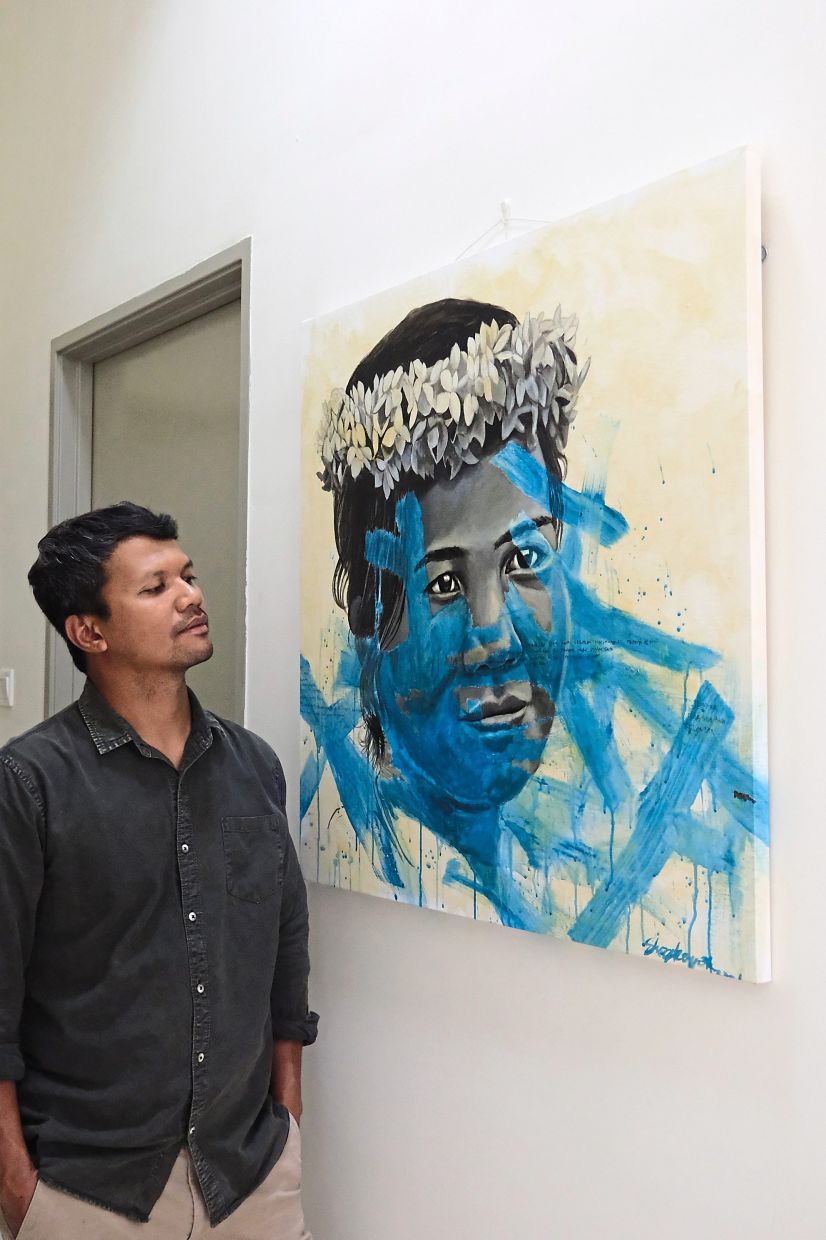Shaq uses his art as a tool to advocate for Orang Asli issues. Photo: The Star/Maria Ibrahim
Art is not just a pretty picture hanging on a wall, but it has to tell a story, says Orang Asli activist and artist Shaq Koyok.
Shaq, 38, from the Temuan tribe in Kampung Orang Asli Pulau Kempas, Selangor, says that there are many issues that his people face, such as deforestation, illegal logging and land rights and these are depicted in his art.
“When I was in high school, I never imagined that art could be used as an advocacy tool. Now, as part of my activism, my mission is to give recognition to indigenous people,” he says.
It all started when he had a traumatic experience at the age of 20, he shares.
“The forest near my village was being deforested for a development project. When I saw that happen, I was extremely traumatised. As a child, I would go to the jungle to play and find food, and it felt like I was losing a part of my home,” he shares.
“Because my family was poor – there were six of us siblings – when there wasn’t enough food on the table, we would go to the jungle to catch fish from the river and forage for edible plants/vegetables, so we had lost a source of sustenance,” he says.
Shaq says that although he felt sad, angry and frustrated, he couldn’t do anything about it.
“The trauma was very real and I even had nightmares about it. This was in 2005 and I was studying art in university during that time.
“I started pouring out my emotions through my art and this helped me cope with the trauma,” he says.
But not only was art an outlet for Shaq’s mental anguish, he decided to use art as his tool to advocate for the issues that the Orang Asli faced.
“I feel like I’m connected to the forest and had to do something about it. I couldn’t just stand by and let people take away our home. Art helped heal my mental health and it also gave me the energy to fight through many land rights issues and save the forest campaigns.
“I realised that art can convey a powerful message and I've tried to include my activism for the Orang Asli in my art. There are many different languages in the world, but art is a universal language. It’s a visual language that people from all over the world can understand,” he explains, adding that art activism is his “life calling”.
Childhood passion
Shaq says that he has been interested in art ever since he was five.
“I saw my older brother drawing and painting after school and was intrigued. He helped inculcate in me an interest for art.
“At school, my teacher noticed my talent and sent me to many art competitions to represent the school, which I won,” he says.
Shaq decided to be an artist when he grew up, and his teacher advised him to complete his SPM and then do an art diploma in university.
He studied in University Technology Mara in Melaka and received his Diploma in Fine Arts. He then continued to do his degree at the university’s Shah Alam campus.
In 2017, he won the Merdeka Award Grant for International Attachment, and went to Australia (National Art Gallery in Parkes, New South Wales), New Zealand (Museum of New Zealand Te Papa Tongarewa, Wellington) and Britain (Eden Project Botanical Garden, Bodelva, Cornwall) for three months in total.
“My research was on comparative studies in indigenous art and how art teaches people about indigenous communities, with a focus on art galleries and museums.
“I want to teach the public about the contribution of indigenous people through my art,, and through these museums and art galleries overseas, I’ve learnt things that I can bring home and implement here in Malaysia because in our country, we still lack in terms of the representation of the indigenous people or Orang Asli,” says the artist who lives in Kuala Lumpur.
Since then, Shaq has given many art presentations and talks, focusing on the importance of indigenous culture being represented in public institutions.
In 2022, Shaq presented at Cop 27, a climate change conference in Egypt.
There have been more events by the government to showcase indigenous culture in art too, he acknowledges.
One of the projects Shaq is currently working on is a mural for the Pulau Carey Cultural Centre in Banting to showcase the Mah Meri indigenous culture for a carnival in September.
Shaq reveals that he often returns to his village to visit his parents even though some of his siblings have moved elsewhere after getting married.
“I’m also helping to develop a cultural centre in my village. The Pulau Kempas Cultural Centre will open in December and showcase Temuan culture to visitors. This is important because rapid modernisation in Selangor is causing us to lose our traditional culture and knowledge of folklore. So, we need to do more to preserve our culture and to showcase it,” he concludes.

















